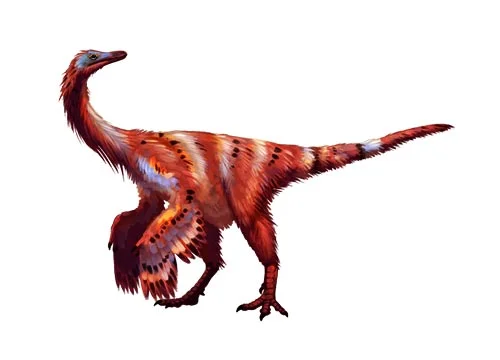Garudimimus (Garuda mimic)

Gah-ru-di-mime-us
Sergei Kurzanov – 1987
Omnivore
Estimated 3 meters long
Large Theropod
G. brevipes (type)
Mongolia - Bayan Shireh Formation
Late Cretaceous, 84-70 million years ago
Garudimimus Facts
Garudimimus (meaning “Garuda mimic”) is a genus of theropod dinosaur that lived during the Late Cretaceous period, around 84-70 million years ago. Its fossils were discovered in the Nemegt Formation of Mongolia in 1981, and it was named and described by Russian paleontologist Sergei Kurzanov in 1987.
Garudimimus belongs to the group of theropod dinosaurs known as ornithomimosaurs, which were characterized by their bird-like appearance and their ostrich-like body structure. Like other ornithomimosaurs, Garudimimus was bipedal and had a long, slender neck, a toothless beak, and long, powerful legs that enabled it to run at high speeds.
The holotype specimen of Garudimimus, which consists of a partial skeleton, provides valuable information about the anatomy and biology of this dinosaur. The skeleton includes a nearly complete skull, several vertebrae, ribs, limb bones, and a partial pelvis. Based on the size and shape of the bones, scientists estimate that Garudimimus was about 3 meters (10 feet) long and weighed around 150 kilograms (330 pounds).
One of the most notable features of Garudimimus is its name, which refers to the Garuda, a mythical bird-like creature from Hindu and Buddhist mythology. The name was given because the dinosaur’s skull resembles the beak of the Garuda. In fact, the beak of Garudimimus is one of the most well-preserved parts of its skull, and it shows evidence of a keratinous covering that would have made it even more bird-like in appearance.
Another interesting feature of Garudimimus is the presence of feathers. While the holotype specimen does not preserve any feathers, other ornithomimosaurs are known to have been feathered, and it is likely that Garudimimus was as well. These feathers would have been used for insulation and possibly for display purposes, as is the case in many modern birds.
Based on the shape of its skull and the structure of its teeth, scientists believe that Garudimimus was an herbivore, feeding on plants such as ferns and horsetails. Its long, slender neck would have allowed it to reach vegetation at different heights, and its beak would have been well-suited for nipping off leaves and stems.
In conclusion, Garudimimus is a fascinating dinosaur that provides important insights into the anatomy and biology of ornithomimosaurs. Its bird-like appearance and potential for being feathered make it a particularly intriguing species, and its herbivorous diet sets it apart from many other theropod dinosaurs. As more fossils are discovered and studied, we are likely to learn even more about this enigmatic dinosaur and its place in the ancient ecosystems of the Late Cretaceous.



